Abstract
Assessments of drinking water safety rely on the assumption that ingestion represents the principal route of exposure. A review of the experimental literature revealed that skin penetration rates for solvents are remarkably high, and that the stratum corneum is a less effective barrier to penetration than traditionally assumed. Based on published skin absorption rates, we used Fick's law (Jos = Kop delta Cos) to determine permeability constants for selected compounds. We then calculated dose per kilogram for nine different exposure situations and compared this to the oral dose per kilogram. We found that skin absorption contributed from 29-91 per cent of the total dose, averaging 64 per cent. Dose per kilogram body weight ranged from .0002 mg/kg-.18 mg/kg, with an average of .03 mg/kg. In weak aqueous solutions, flux of the solute is directly proportional to concentration. Laboratory approaches differ markedly from environmental exposures and can underestimate absorption. We conclude that skin absorption of contaminants in drinking water has been underestimated and that ingestion may not constitute the sole or even primary route of exposure.
Full text
PDF
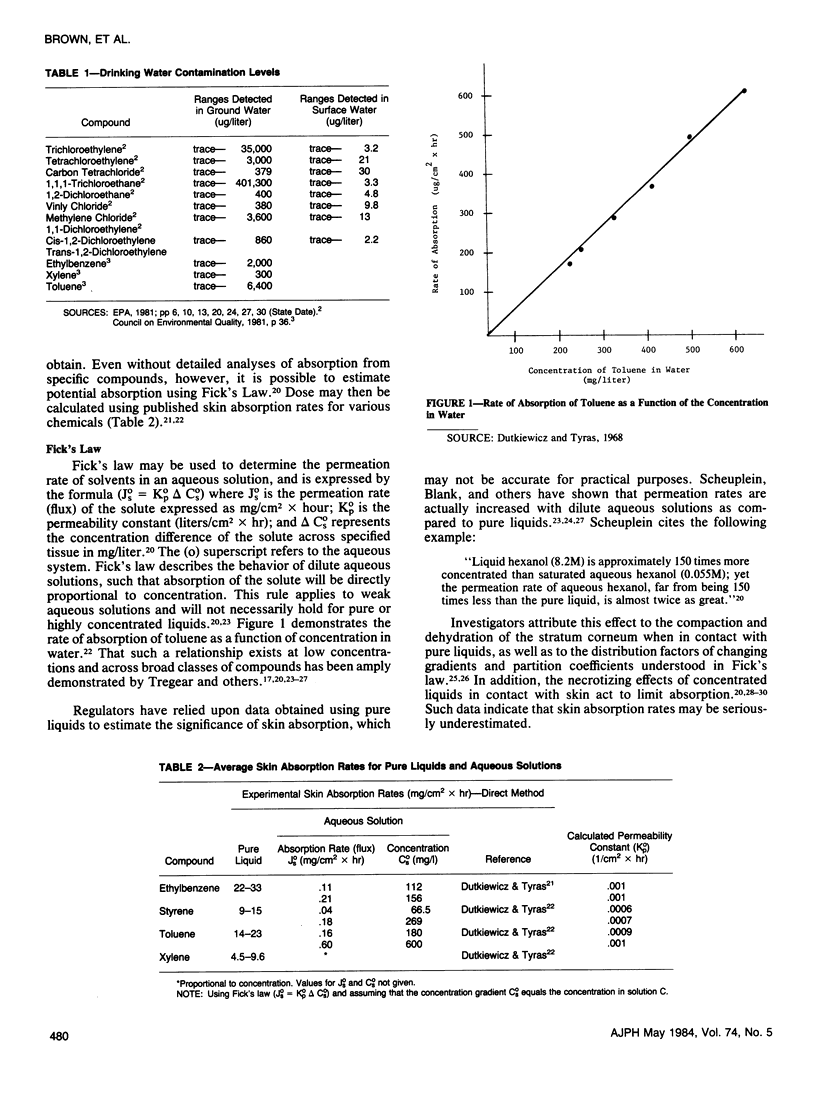
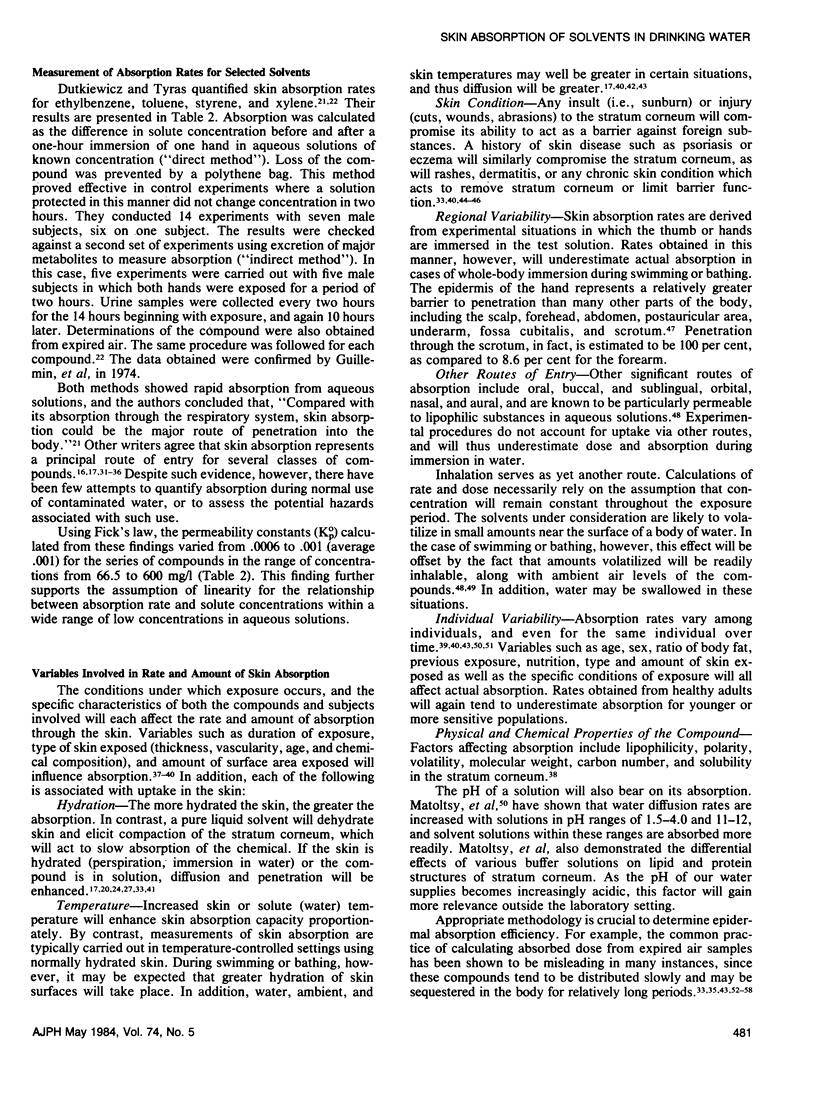
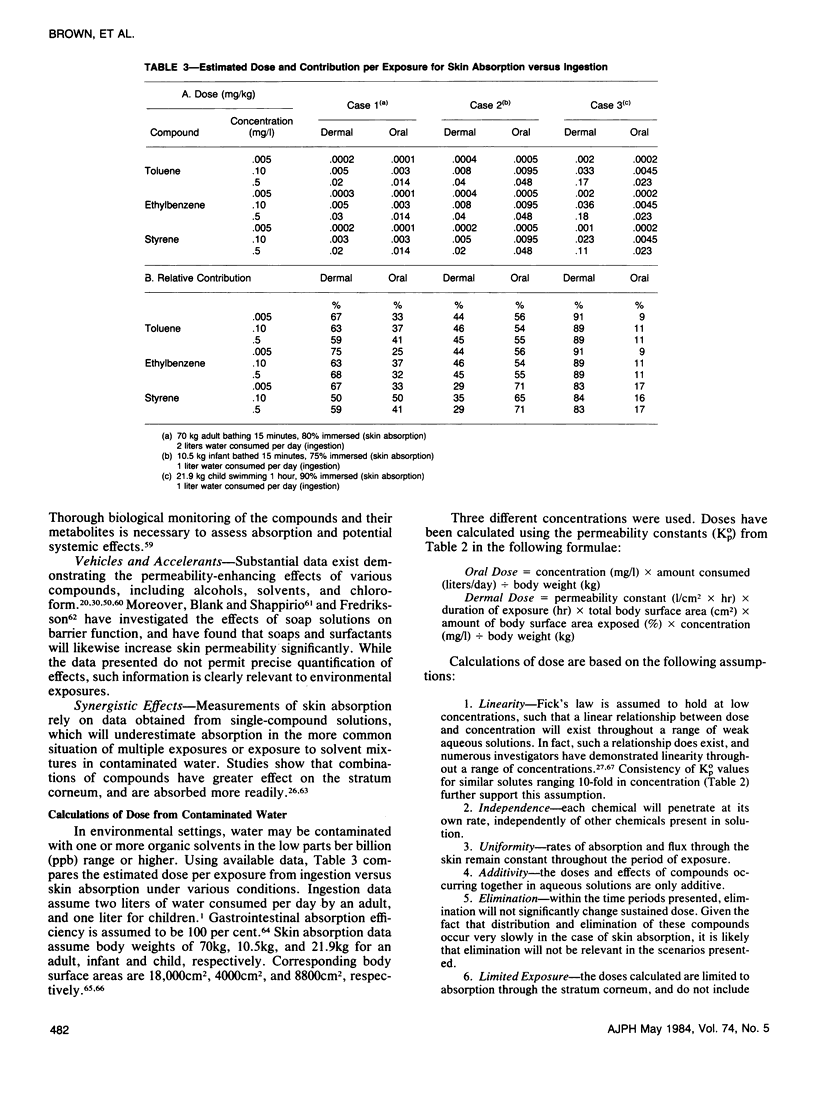
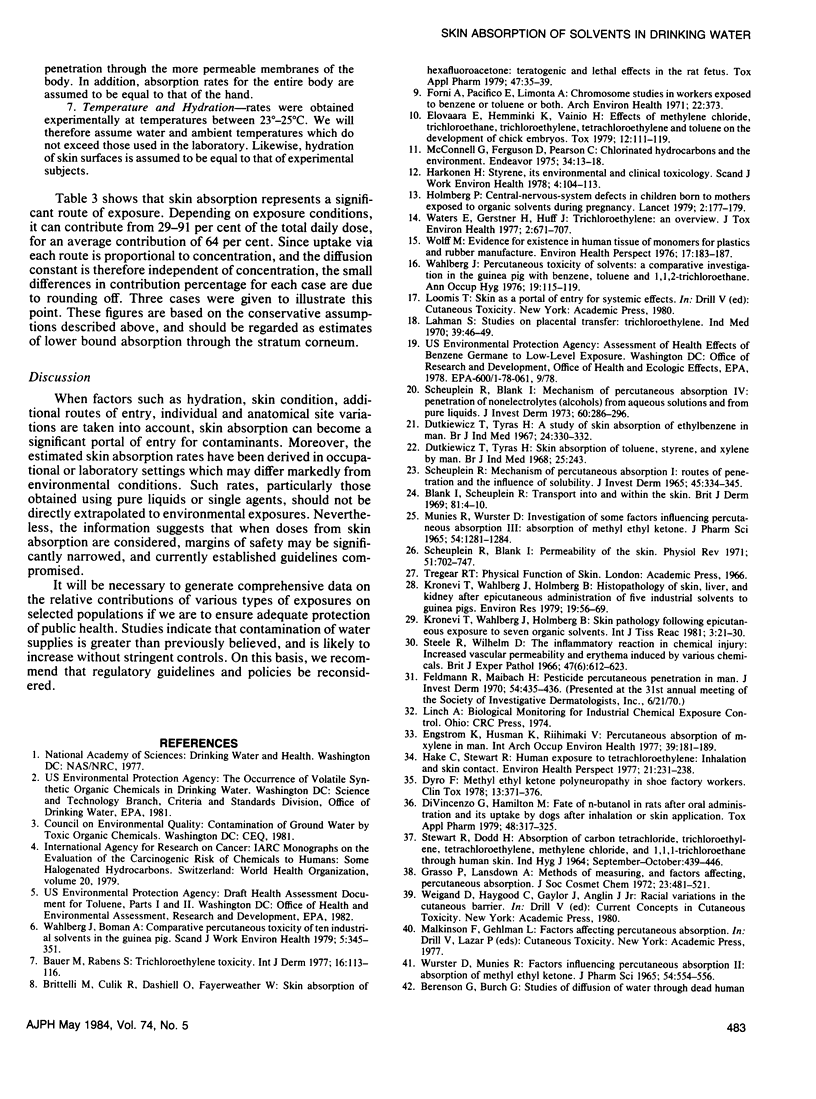
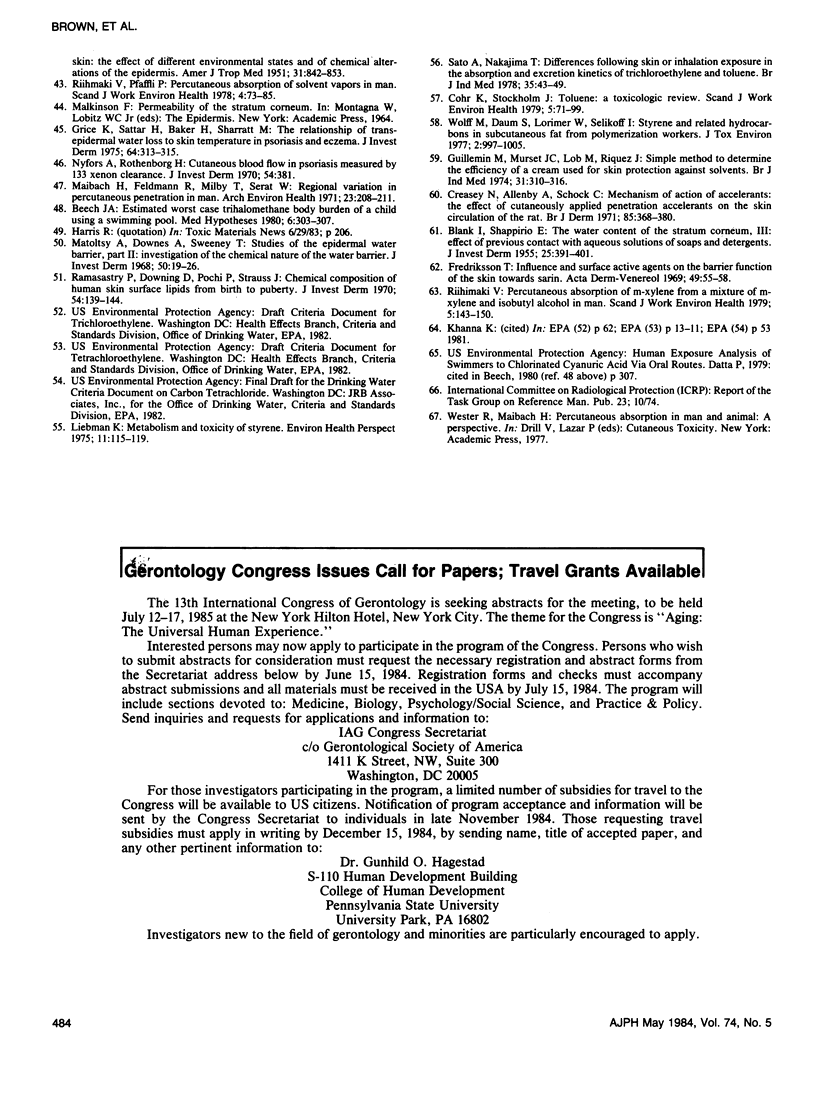
Selected References
These references are in PubMed. This may not be the complete list of references from this article.
- BLANK I. H., SHAPPIRIO E. B. The water content of the stratum corneum. III. Effect of previous contact with aqueous solutions of soaps and detergents. J Invest Dermatol. 1955 Dec;25(6):391–401. [PubMed] [Google Scholar]
- Bauer M., Rabens S. F. Trichloroethylene toxicity. Int J Dermatol. 1977 Mar;16(2):113–116. doi: 10.1111/j.1365-4362.1977.tb01837.x. [DOI] [PubMed] [Google Scholar]
- Beech J. A. Estimated worst case trihalomethane body burden of a child using a swimming pool. Med Hypotheses. 1980 Mar;6(3):303–307. doi: 10.1016/0306-9877(80)90127-9. [DOI] [PubMed] [Google Scholar]
- Brittelli M. R., Culik R., Dashiell O. L., Fayerweather W. E. Skin absorption of hexafluoroacetone: teratogenic and lethal effects in the rat fetus. Toxicol Appl Pharmacol. 1979 Jan;47(1):35–39. doi: 10.1016/0041-008x(79)90068-1. [DOI] [PubMed] [Google Scholar]
- Cohr K. H., Stokholm J. Toluene. A toxicologic review. Scand J Work Environ Health. 1979 Jun;5(2):71–90. doi: 10.5271/sjweh.2664. [DOI] [PubMed] [Google Scholar]
- Creasey N. H., Allenby A. C., Schock C. Mechanism of action of accelerants. The effect of cutaneously-applied penetration accelerants on the skin circulation of the rat. Br J Dermatol. 1971 Oct;85(4):368–380. [PubMed] [Google Scholar]
- DiVincenzo G. D., Hamilton M. L. Fate of n-butanol in rats after oral administration and its uptake by dogs after inhalation or skin application. Toxicol Appl Pharmacol. 1979 Apr;48(2):317–325. doi: 10.1016/0041-008x(79)90038-3. [DOI] [PubMed] [Google Scholar]
- Dutkiewicz T., Tyras H. A study of the skin absorption of ethylbenzene in man. Br J Ind Med. 1967 Oct;24(4):330–332. doi: 10.1136/oem.24.4.330. [DOI] [PMC free article] [PubMed] [Google Scholar]
- Dutkiewicz T., Tyras H. Skin absorption of toluene, styrene, and xylene by man. Br J Ind Med. 1968 Jul;25(3):243–243. doi: 10.1136/oem.25.3.243. [DOI] [PMC free article] [PubMed] [Google Scholar]
- Dyro F. M. Methyl ethyl ketone polyneuropathy in shoe factory workers. Clin Toxicol. 1978;13(3):371–376. doi: 10.3109/15563657808988244. [DOI] [PubMed] [Google Scholar]
- Elovaara E., Hemminki K., Vainio H. Effects of methylene chloride, trichloroethane, trichloroethylene, tetrachloroethylene and toluene on the development of chick embryos. Toxicology. 1979 Feb;12(2):111–119. doi: 10.1016/0300-483x(79)90037-4. [DOI] [PubMed] [Google Scholar]
- Engström K., Husman K., Riihimäki V. Percutaneous absorption of m-xylene in man. Int Arch Occup Environ Health. 1977 Aug 31;39(3):181–189. doi: 10.1007/BF00405662. [DOI] [PubMed] [Google Scholar]
- Fori A., Pacifico E., Limonta A. Chromosome studies in workers exposed to benzene or toluene or both. Arch Environ Health. 1971 Mar;22(3):373–378. [PubMed] [Google Scholar]
- Grice K., Sattar H., Baker H., Sharratt M. The relationship of transepidermal water loss to skin temperature in psoriasis and eczema. J Invest Dermatol. 1975 May;64(5):313–315. doi: 10.1111/1523-1747.ep12512258. [DOI] [PubMed] [Google Scholar]
- Guillemin M., Murset J. C., Lob M., Riquez J. Simple method to determine the efficiency of a cream used for skin protection against solvents. Br J Ind Med. 1974 Oct;31(4):310–316. doi: 10.1136/oem.31.4.310. [DOI] [PMC free article] [PubMed] [Google Scholar]
- Hake C. L., Stewart R. D. Human exposure to tetrachloroethylene: inhalation and skin contact. Environ Health Perspect. 1977 Dec;21:231–238. doi: 10.1289/ehp.7721231. [DOI] [PMC free article] [PubMed] [Google Scholar]
- Holmberg P. C. Central-nervous-system defects in children born to mothers exposed to organic solvents during pregnancy. Lancet. 1979 Jul 28;2(8135):177–179. doi: 10.1016/s0140-6736(79)91438-7. [DOI] [PubMed] [Google Scholar]
- Härkönen H. Styrene, its experimental and clinical toxicology. A review. Scand J Work Environ Health. 1978;4 (Suppl 2):104–113. [PubMed] [Google Scholar]
- Kronevi T., Wahlberg J. E., Holmberg B. Skin pathology following epicutaneous exposure to seven organic solvents. Int J Tissue React. 1981 Mar;3(1):21–30. [PubMed] [Google Scholar]
- Kronevi T., Wahlberg J., Holmberg B. Histopathology of skin, liver, and kidney after epicutaneous administration of five industrial solvents to guinea pigs. Environ Res. 1979 Jun;19(1):56–69. doi: 10.1016/0013-9351(79)90034-3. [DOI] [PubMed] [Google Scholar]
- Leibman K. C. Metabolism and toxicity of styrene. Environ Health Perspect. 1975 Jun;11:115–119. doi: 10.1289/ehp.7511115. [DOI] [PMC free article] [PubMed] [Google Scholar]
- Maibach H. I., Feldman R. J., Milby T. H., Serat W. F. Regional variation in percutaneous penetration in man. Pesticides. Arch Environ Health. 1971 Sep;23(3):208–211. doi: 10.1080/00039896.1971.10665987. [DOI] [PubMed] [Google Scholar]
- Matoltsy A. G., Downes A. M., Sweeney T. M. Studies of the epidermal water barrier. II. Investigation of the chemical nature of the water barrier. J Invest Dermatol. 1968 Jan;50(1):19–26. [PubMed] [Google Scholar]
- McConnell G., Ferguson D. M., Pearson C. R. Chlorinated hydrocarbons and the environment. Endeavour. 1975 Jan;34(121):13–18. doi: 10.1016/0160-9327(75)90062-9. [DOI] [PubMed] [Google Scholar]
- Munies R., Wurster D. E. Investigation of some factors influencing percutaneous absorption. 3. Absorption of methyl ethyl ketone. J Pharm Sci. 1965 Sep;54(9):1281–1284. doi: 10.1002/jps.2600540912. [DOI] [PubMed] [Google Scholar]
- Nyfors A., Rothenborg H. W. Cutaneous blood flow in psoriasis measured by 133-Xenonlearance. J Invest Dermatol. 1970 May;54(5):381–385. doi: 10.1111/1523-1747.ep12259086. [DOI] [PubMed] [Google Scholar]
- Ramasastry P., Downing D. T., Pochi P. E., Strauss J. S. Chemical composition of human skin surface lipids from birth to puberty. J Invest Dermatol. 1970 Feb;54(2):139–144. doi: 10.1111/1523-1747.ep12257164. [DOI] [PubMed] [Google Scholar]
- Riihimäki V. Percutaneous absorption of m-xylene from a mixture of m-xylene and isobutyl alcohol in man. Scand J Work Environ Health. 1979 Jun;5(2):143–150. doi: 10.5271/sjweh.2658. [DOI] [PubMed] [Google Scholar]
- Riihimäki V., Pfäffli P. Percutaneous absorption of solvent vapors in man. Scand J Work Environ Health. 1978 Mar;4(1):73–85. doi: 10.5271/sjweh.2721. [DOI] [PubMed] [Google Scholar]
- STEWART R. D., DODD H. C. ABSORPTION OF CARBON TETRACHLORIDE, TRICHLOROETHYLENE, TETRACHLOROETHYLENE, METHYLENE CHLORIDE, AND 1,1,1-TRICHLOROETHANE THROUGH THE HUMAN SKIN. Am Ind Hyg Assoc J. 1964 Sep-Oct;25:439–446. doi: 10.1080/00028896409342621. [DOI] [PubMed] [Google Scholar]
- Sato A., Nakajima T. Differences following skin or inhalation exposure in the absorption and excretion kinetics of trichloroethylene and toluene. Br J Ind Med. 1978 Feb;35(1):43–49. doi: 10.1136/oem.35.1.43. [DOI] [PMC free article] [PubMed] [Google Scholar]
- Scheuplein R. J., Blank I. H. Mechanism of percutaneous absorption. IV. Penetration of nonelectrolytes (alcohols) from aqueous solutions and from pure liquids. J Invest Dermatol. 1973 May;60(5):286–296. doi: 10.1111/1523-1747.ep12723090. [DOI] [PubMed] [Google Scholar]
- Scheuplein R. J., Blank I. H. Permeability of the skin. Physiol Rev. 1971 Oct;51(4):702–747. doi: 10.1152/physrev.1971.51.4.702. [DOI] [PubMed] [Google Scholar]
- Scheuplein R. J. Mechanism of percutaneous adsorption. I. Routes of penetration and the influence of solubility. J Invest Dermatol. 1965 Nov;45(5):334–346. doi: 10.1038/jid.1965.140. [DOI] [PubMed] [Google Scholar]
- Steele R. H., Wilhelm D. L. The inflammatory reaction in chemical injury. I. Increased vascular permeability and erythema induced by various chemicals. Br J Exp Pathol. 1966 Dec;47(6):612–623. [PMC free article] [PubMed] [Google Scholar]
- Wahlberg J. E., Boman A. Comparative percutaneous toxicity of ten industrial solvents in the guinea pig. Scand J Work Environ Health. 1979 Dec;5(4):345–351. doi: 10.5271/sjweh.2647. [DOI] [PubMed] [Google Scholar]
- Wahlberg J. E. Percutaneous toxicity of solvents. A comparative investigation in the guinea pig with benzene, toluene and 1,1,2-trichloroethane. Ann Occup Hyg. 1976 Nov;19(2):115–119. doi: 10.1093/annhyg/19.2.115. [DOI] [PubMed] [Google Scholar]
- Waters E. M., Gerstner H. B., Huff J. E. Trichloroethylene. I. An overview. J Toxicol Environ Health. 1977 Jan;2(3):671–707. doi: 10.1080/15287397709529469. [DOI] [PubMed] [Google Scholar]
- Wolff M. S., Daum S. M., Lorimer W. V., Selikoff I. J. Styrene and related hydrocarbons in subcutaneous fat from polymerization workers. J Toxicol Environ Health. 1977 May;2(5):997–1005. doi: 10.1080/15287397709529498. [DOI] [PubMed] [Google Scholar]
- Wolff M. S. Evidence for existence in human tissues of monomers for plastics and rubber manufacture. Environ Health Perspect. 1976 Oct;17:183–187. doi: 10.1289/ehp.7617183. [DOI] [PMC free article] [PubMed] [Google Scholar]
- Wurster D. E., Munies R. Factors influencing percutaneous absorption. II. Absorption of methyl ethyl ketone. J Pharm Sci. 1965 Apr;54(4):554–556. doi: 10.1002/jps.2600540412. [DOI] [PubMed] [Google Scholar]


